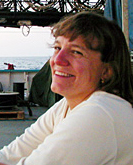I’m well aware that there is tremendous variation in the civil rights of people with disabilities from country to country. But I was very surprised to learn yesterday that there is a restriction in the U.K. that would probably prevent me from participating in an oceanographic research cruise on some U.K. research vessels.
Read More
This is our fifth day at sea. The weather is still cool and foggy, but the winds have dropped to almost nothing. Because high winds lead to high seas, we are often most interested in the wind forecast and not so much in the temperature or rain forecasts. Tomorrow we might be near the edge […]
Read More
This morning we woke up early to get ready for the first sound source mooring deployment on this cruise leg. As described in earlier posts, the sound sources will be used to track subsurface floats drifting with the deepest currents in the North Atlantic. Each sound source will transmit an 80-second long acoustic tone once […]
Read More
Sound is used by humans and marine life to communicate underwater. This is partly because electro-magnetic waves (including light) do not penetrate very far through water. Sunlight is more or less gone below a few 10s of meters, and the rest of the ocean depths are in complete darkness. On the other hand, sound travels […]
Read More
Today I was recalling a topic that I discussed years ago with a professional personal coach. At the time, I was preparing to go on another research cruise, this time on an unfamiliar research vessel (from Greece) and with many students and scientists I had not met previously. I was quite anxious about the trip. […]
Read More
Picking up from Part 2 (because I forgot to paste in the text for the whole story).. The monitoring float heard very clear signals from two of the three sound sources, and a hint of the third one too. The latter sound source is rather far away from where the floats were deployed, and on […]
Read More
Right after leaving port this morning, we had a routine safety meeting and drill. As part of this, we were shown how to use short-term oxygen systems (with just enough air to get out of your cabin in the event of a fire). I couldn’t see the demonstration, so I just asked if I could […]
Read More
This brings me to the first good news for the OSNAP float program. The first three of the 10 OSNAP sound sources were deployed from the Knorr as it made its way from Woods Hole to Reykjavik. At the same time, two “monitoring” RAFOS floats were released with a shortened mission. Their purpose was just […]
Read More
We finally left Reykjavik today at 0900 as scheduled, under sunny skies. Temps are still chilly – around 50F. But we are steaming downwind so the ship has a rather gentle roll – good for getting those sea legs. We are heading more or less to our first moorings site, which will take about two […]
Read More
This morning the OSNAP float group got some good news. Before I reveal the good news, I need to explain how floats are being used in OSNAP. Freely drifting, neutrally buoyant floats will be released from the ship and sink down to near the sea floor. There they will drift with the deepest currents in […]
Read More
About Amy Bower
 Amy Bower is a physical oceanographer at the Woods Hole Oceanographic Institution. She has been chasing ocean currents in the Atlantic and Indian Oceans for over 25 years, primarily by releasing acoustically tracked floats far below the sea surface. Legally blind since her mid-20s, Amy uses adaptive technology to continue her research.
Amy Bower is a physical oceanographer at the Woods Hole Oceanographic Institution. She has been chasing ocean currents in the Atlantic and Indian Oceans for over 25 years, primarily by releasing acoustically tracked floats far below the sea surface. Legally blind since her mid-20s, Amy uses adaptive technology to continue her research.
Related Links

